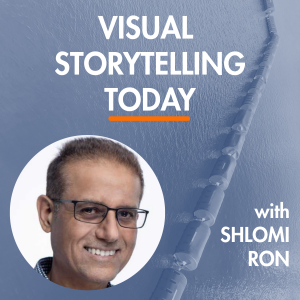
How I started My Podcast
How I started My Podcast https://www.visualstorytell.com/wp-content/uploads/2021/09/How-I-Started-My-Podcast-Thumb.jpg 366 222 Shlomi Ron Shlomi Ron https://secure.gravatar.com/avatar/995c0cf093380b90c7704fda398c9addf4e5c605afbc92af5c3f01f67d65aa41?s=96&d=mm&r=g- Shlomi Ron
- no comments
Are you hosting a podcast to show vs. tell your brand purpose?
It’s no secret, in recent years podcasts have become a powerful channel to tell meaningful stories that engage audiences, while building brand, and opening opportunities.
Interest in audio in general has been surging and further amplified during the pandemic with the Clubhouse craze that drove copycats by big players.
As for podcasts, the audience is getting bigger.
Nearly six in ten (57%) consumers above the age of 12 in the US have listened to at least one podcast (Statista, 2021).
You may say “cool, but how do podcasts that are typically audio-based relate to visual storytelling?”
Fair point! The way I see it, I’d like to stretch the definition of visual storytelling beyond visual media formats (photos, videos, VR) to include also audio formats.
Why?
Inspiring audio podcasts trigger visual stories in the mind of listeners.
You hear a guest describing her backstory with different stops in her personal and career lives. Some details you may have personally experienced and that activates stronger emotional visuals from your own memory chest.
That’s where “Theater of the Mind” comes into play.
A term that originally started as a radio jargon to describe all the various tactics broadcasters used to conjure vivid images for their shows using only sound.
And guess what? You can do the same – visualize your brand narrative in your customers’ minds and generate leads to your business hosting your own podcast.
You may already have a podcast or you are still on the fence. Regardless, here is how I started and run my podcast.
My Top 6 Tips
1. Angle
I started the Visual Storytelling Today back in 2017 with the goal of serving as #1 source for the latest actionable visual storytelling ideas marketers and business leaders can apply to their businesses today.
In short, visual storytelling in the intersection of marketing.
2. Visual

I created the podcast cover (square size) that appears on all podcast networks as well the episode cover below (landscape size) that appears on blog posts and social promos.
To align with VSI’s brand I followed VSI’s brand book for color, font type, and photo themes – created by Abbey Melsheimer, a great brand identity designer and a friend.
For the podcast cover, I chose a minimalist approach to boost readability for small size displays. This is essential as your visual would compete side by side against a ton of other shows on podcast platforms.
On top of audio, I use video to allow guests to share visual examples
like analyzing photos in this popular episode
In case you wondered, what’s the deal with the photo? I took it during one of my visits back home in Tel Aviv.
One morning, I was taking a walk on the beach when on my right I saw this water reservoir with bright deep blue waters contrasted by chained red barrels. I took the photo without thinking too much.
Later, I chose it as backdrop image for the podcast, as a way to visualize each episode (barrel) as an individual story guest shares that overtime turns into a nice looking chain – VSI’s larger narrative:
Sharing wow moments that allow people to see themselves
mirrored in brand stories that matter
3. Format
I use the 45-minute interview format where I feature notable visual storytellers and dig deeper into their journeys, failures, successes, and lessons learned.
4. Strategy
Unlike narrow-focused business podcasts, I am a great believer that in this day and age, it’s important to interview thought leaders not just within your industry but also relevant people outside your industry to get fresh perspectives.
That’s why on my podcast you’ll find guests – such as a family therapist, a restaurant owner or an Italian ER physician alongside prominent industry leaders from IBM, New York Times or Adweek.
This is where new ideas you’d never consider bubble up.
5. Frequency
Here you have various cadence levels from weekly, bi-weekly, monthly and whenever.
The higher frequency you’d likely need a support team, the lower – a single host can manage.
I aim to publish a monthly episode, but sometimes it doesn’t happen as I haven’t found the right topic/guest. Hence, I produce the show on my own.
6. Distribution
Since people consume content in various ways and hey! to justify the ‘visual’ in the show’s name, I distribute the show in three formats: video, audio and a blog post.
For me, it’s been an exciting learning journey as I was optimizing various aspects of the show from programming, interview style to tech gear and new video graphics.
Today the show is ranked in the top 10 of business storytelling podcasts on the Web, which is not so bad since I took the “artisanal one-man approach.”
Slower publishing frequency is also part of the slow content marketing movement that is all about “less-but-better content will deliver improved marketing results (CMI)”.
It creates anticipation and activates the scarcity principle.
Through the show, I’ve met great people; some have become customers, collaborators, and great friends.
In many cases, I was also invited as a guest on their shows.
In short, podcasting allows you to validate your larger brand narrative one episode at a time by turning the focus from you to your ideal customer, learning a ton along the way and establishing yourself as a thought leader in your niche.
Need help starting your podcast?
Book a chat and I’d be happy to explore ways to turn your expertise into a great show.
- Posted In:
- Story Making
- Story Visualizing
- Visual Storytelling
Shlomi Ron
Shlomi Ron is the founder and CEO of the Visual Storytelling Institute, a Miami-based think tank with a mission to bring the gospel of visual storytelling from the world of art to more human-centric and purpose-driven marketing. A digital marketing veteran with over 20 years of experience working both on the agency and brand sides for Fortune 100/500 brands such as Nokia, IBM, and American Express. He started VSI to combine his marketing expertise with his passion for visual stories stemming from his interests in classic Italian cinema and managing the estate of video art pioneer, Buky Schwartz. At VSI, he helps brands rise above the communication noise through visual storytelling consulting, training, and thought leadership. Select clients include Estée Lauder, Microsoft, and Cable & Wireless – to name a few. He currently teaches Brand Storytelling at the University of Miami’s Business School. Thought leader and speaker at key marketing conferences. He is also the host of the Visual Storytelling Today podcast, which ranks in the top 10 best business storytelling podcasts on the Web. His book: Total Acuity: Tales with Marketing Morals to Help You Create Richer Visual Brand Stories. Outside work, he is a nascent bread baker, The Moth fan, and longtime fedora wearer likely to jive with his classic Italian cinema interest.
All stories by: Shlomi RonYou might also like
This site uses Akismet to reduce spam. Learn how your comment data is processed.




Leave a Reply